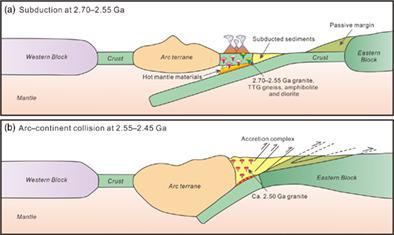当前位置:
X-MOL 学术
›
Geolog. J.
›
论文详情
Our official English website, www.x-mol.net, welcomes your feedback! (Note: you will need to create a separate account there.)
Neoarchean to Palaeoproterozoic tectonic evolution of the Trans‐North China Orogen, North China Craton: Evidence from zircon U–Pb geochronology, Lu–Hf isotopes, and geochemistry of the Zanhuang Complex
Geological Journal ( IF 1.8 ) Pub Date : 2020-09-23 , DOI: 10.1002/gj.3998 Kangxing Shi 1 , Changming Wang 1 , Bin Du 1, 2 , Qi Chen 1 , Jiaxuan Zhu 1
Geological Journal ( IF 1.8 ) Pub Date : 2020-09-23 , DOI: 10.1002/gj.3998 Kangxing Shi 1 , Changming Wang 1 , Bin Du 1, 2 , Qi Chen 1 , Jiaxuan Zhu 1
Affiliation

|
Research on the Zanhuang Complex has been one of the hotspots in the Neoarchean–Palaeoproterozoic tectonic evolution of the Trans‐North China Orogen (TNCO) in the North China Craton (NCC). Here, we present data from petrology, geochemistry, zircon U–Pb geochronology, and Lu–Hf isotopes on a suite of granite, diorite, TTG gneiss, and amphibolite in the Zanhuang Complex to characterize these rocks and understand their genesis. Zircon U–Pb data yield magmatic ages of 2,607 Ma for granite, 2,599 Ma for diorite and 2,561 Ma for TTG gneiss, with subsequent thermal event ages of 2,530 and 2,471 Ma. Lu–Hf isotopes show εHf(t) values ranging from 0.04 to 7.11 and crustal model ages of 2,700–3,100 Ma for the diorite, indicating a Meso‐ to Neoarchean mantle source with minor input of crustal components. The granite and TTG gneiss have the characteristics of volcanic‐arc granite, with low Sr/Y and (La/Yb)N, high Cr and Ni contents, positive Pb and K anomalies and negative Nb, Ta, P, and Ti anomalies. The amphibolite and diorite are similar to island arc basalt, with low K2O, Sr/Y, (La/Yb)N, and high FeOT, positive Pb anomaly, negative Nb, Ta, and Ti anomalies and absence of obvious Ce anomaly. These signatures indicate that these rocks were likely formed in a subduction setting. We have proposed a model of subduction–collision process in the TNCO, including subduction at ca. 2.70–2.55 Ga, arc–continent collision at ca. 2.55–2.45 Ga, extension and rifting at ca. 2.30–2.05 Ga, and continent–continent collision at ca. 1.90–1.75 Ga. Our results are consistent with the previous models on the tectonic evolution in the NCC and provide further insights into the Neoarchean–Palaeoproterozoic tectonic history of the craton.
中文翻译:

华北克拉通跨华北造山带的新旧纪到古元古代构造演化:锆石U–Pb年代学,Lu–Hf同位素和the煌复杂地球化学的证据
an煌综合体的研究一直是华北克拉通(NCC)的北华北造山带(TNCO)的新古宙-古元古代构造演化的热点之一。在这里,我们提供了来自赞皇岩体中一组花岗岩,闪长岩,TTG片麻岩和角闪石的岩石学,地球化学,锆石U-Pb年代学和Lu-Hf同位素数据,以表征这些岩石并了解其成因。锆石U–Pb数据的花岗岩岩浆年龄为2,607 Ma,闪闪岩岩浆年龄为2,599 Ma,TTG片麻岩的岩浆年龄为2,561 Ma,随后的热事件年龄分别为2,530和2,471 Ma。鲁-铪同位素秀ε铪(ŧ)的值范围从0.04到7.11,并且该闪长岩的地壳模型年龄为2,700-3,100 Ma,这表明中,新太古宙地幔源中地壳成分的输入很少。花岗岩和TTG片麻岩具有火山弧花岗岩的特征,具有低的Sr / Y和(La / Yb)N,高的Cr和Ni含量,正的Pb和K异常以及负的Nb,Ta,P和Ti异常。闪长岩和闪长岩类似于岛弧玄武岩,具有低K 2 O,Sr / Y,(La / Yb)N和高FeO T,正Pb异常,负Nb,Ta和Ti异常,并且没有明显的Ce异常。这些特征表明这些岩石可能是在俯冲环境中形成的。我们在TNCO中提出了一个俯冲-碰撞过程的模型,包括在大约2005年的俯冲。2.70–2.55 Ga,约弧度处的弧-陆碰撞。2.55–2.45 Ga,延伸和裂口于约。大约2.30–2.05 Ga,以及大陆与大陆的碰撞。1.90–1.75 Ga。我们的结果与以前的NCC构造演化模型相一致,并为克拉通的新太古代-古元古代构造历史提供了进一步的见解。
更新日期:2020-09-23
中文翻译:

华北克拉通跨华北造山带的新旧纪到古元古代构造演化:锆石U–Pb年代学,Lu–Hf同位素和the煌复杂地球化学的证据
an煌综合体的研究一直是华北克拉通(NCC)的北华北造山带(TNCO)的新古宙-古元古代构造演化的热点之一。在这里,我们提供了来自赞皇岩体中一组花岗岩,闪长岩,TTG片麻岩和角闪石的岩石学,地球化学,锆石U-Pb年代学和Lu-Hf同位素数据,以表征这些岩石并了解其成因。锆石U–Pb数据的花岗岩岩浆年龄为2,607 Ma,闪闪岩岩浆年龄为2,599 Ma,TTG片麻岩的岩浆年龄为2,561 Ma,随后的热事件年龄分别为2,530和2,471 Ma。鲁-铪同位素秀ε铪(ŧ)的值范围从0.04到7.11,并且该闪长岩的地壳模型年龄为2,700-3,100 Ma,这表明中,新太古宙地幔源中地壳成分的输入很少。花岗岩和TTG片麻岩具有火山弧花岗岩的特征,具有低的Sr / Y和(La / Yb)N,高的Cr和Ni含量,正的Pb和K异常以及负的Nb,Ta,P和Ti异常。闪长岩和闪长岩类似于岛弧玄武岩,具有低K 2 O,Sr / Y,(La / Yb)N和高FeO T,正Pb异常,负Nb,Ta和Ti异常,并且没有明显的Ce异常。这些特征表明这些岩石可能是在俯冲环境中形成的。我们在TNCO中提出了一个俯冲-碰撞过程的模型,包括在大约2005年的俯冲。2.70–2.55 Ga,约弧度处的弧-陆碰撞。2.55–2.45 Ga,延伸和裂口于约。大约2.30–2.05 Ga,以及大陆与大陆的碰撞。1.90–1.75 Ga。我们的结果与以前的NCC构造演化模型相一致,并为克拉通的新太古代-古元古代构造历史提供了进一步的见解。


























 京公网安备 11010802027423号
京公网安备 11010802027423号